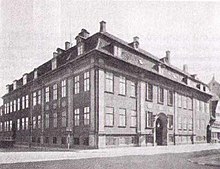Barchmann Mansion
| Wedell Mansion | |
|---|---|
Wedells Palæ | |
 The mansion seen from Prince's Bridge | |
 | |
| General information | |
| Architectural style | Baroque |
| Location | Copenhagen, Denmark |
| Country | Denmark |
| Coordinates | 55°40′26″N 12°34′38″E / 55.6740°N 12.5772°ECoordinates: 55°40′26″N 12°34′38″E / 55.6740°N 12.5772°E |
| Construction started | 1740 |
| Inaugurated | 1742 |
| Owner | |
| Design and construction | |
| Architect | Philip de Lange |
Barchmann Mansion (Danish: Barchmanns Palæ) is a Baroque style town mansion overlooking Frederiksholm Canal in central Copenhagen, Denmark. Built in the early 1740s to designs by Philip de Lange, it is also known as the Wedell Mansion (Danish: Wedells Palæ) after the current owner. It was listed in the Danish registry of protected buildings and places in 1918. An extension from 1748 is now home to Johan Borup's Folk High School.
History[]
Bachmann[]

The house was built in 1740–41 by Philip de Lange for affluent Jacob Barchmann. Barchmann did not live in it himself but rented it out to foreign envoys.[1] The original building was extended in 1748, first along the canal and a little later along Ny Kongensgade. Barchmann's widow kept the properties after her husband's death.
Changing owners, 1779–1811[]
Borchmann's properties were on 11 March 1779 sold to Joahn & William Brown. The firm went bankrupt in 1787 and the three properties were then sold to different buyers. The corner mansion was in early 1788 sold to lawyer Christopher Hansteen. In 1795, it was acquired by Supreme Court lawyer Carl Henrik Wilster.
The mansion was in January 1800 acquired by Philip Ryan (1766-1808). He was originally from Saint Croix where hois father Henry Ryan was the owner of the sugar plantation . Ryan had moved to Copenhagen in 1780 where he initially worked for Dybzfekd, Meyer / Co and later started his own trading firm. His new mansion was later the same year sold to John Christmas. On 2 January 1804, it was acquired by Jens Friedenreich Hage. On 4 December 1809, it was acquired by merchant Jacob Salomon Meyer.
Scavenius and Treschow families[]

The Barchmann Mansion was in 1811 acquired by the industrious landowner Jacob Brønnum Scavenius. He had made a fortune in Danish India and on his return to Denmark acquired Ghorslev Manor kn Stevns. His widow kept the property after her husband's death. The Scavenius family owned it until 1877.
The property was in 1898 acquired by Willum Frederik Treschow. He left it to Frederik Vilhelm Rosenkilde Treschow. His widow Andrea Bjørn Rothe owned the mansion until her death in 1884.[2]
The Friis and Wedel families[]
The Barchmann Mansion was in 1885 acquired by Mogens, Count Friis. The Frederiksholms Kanal 24 extension was also acquired by him.
In 1923, the house came on the hands of the Wedell family when Inger Wedell née Krag-Juel-Vind-Frijs inherited the property from her father, Count Mogens of Frijsenborg.
In 1926, the house was divided into two separate properties when Borup Folk High School moved into Frederiksholms Kanal 24.[2] Since 1982, the remaining part has been owned by the Krag-Juel-Vind-Frijs/Wedells family.[3]
Architecture[]

The mansion is a three-winged building in two storeys under a mansard roof. The principal facade faces Ny Kongensgade. The original building is seven bays towards the canal and nine towards the street. It is built in red brick and decorated with sandstone pilasters in the giant order, cornice, decorations and a portal. The facade to the right of the portal covers the stables to obtain the symmetry required by the Baroque style.[4] The lateral wing away from the canal is narrow and therefore only has a half mansard. It has two carriage gates and a low mezzanine
The extensions added seven bays along the canal and three bays along the street. The extension along the canal also has pilasters, but in red brick instead of sandstone, and the cornice is omitted.[4]
The building was altered by Thorvald Jørgensen in 1903. The two main wings towards Frederiksholms Kanal and Ny Kongensgade, were listed in 1818 and the listing was extended to include the lateral wing in 2000.[1]
Today[]
Since 2008 the building has been owned by , the second largest private land owner in Denmark, whose other holdings include and Frijsenborg in Jutland.[5] The Borup Folk High School is still based at 24 Frederiksholms Kanal.
List of owners[]
- (1740-1764) Jacob Barchmann
- (1764-1779) Christine Berg gift Barchmann
- (1779-1787) John Brown / William Brown
- (1787-1795) Christopher Hansteen
- (1795-1800) Carl Henrik Wilster,
- (1800) Philip Ryan
- (1800-1804) John Christmas
- (1804-1809) Jens Friedenreich Hage
- (1809-1811) Jacob Salomon Meyer
- (1811) Jacob Rosted / Johannes Plenge
- (1811-1820) Jacob Brønnum Scavenius
- (1820-1825) Enkefru Scavenius
- (1825-1827) Slægten Scavenius
- (1827-1869) Willum Frederik Treschow
- (1869) Frederik Wilhelm Treschow
- (1869-1885) Andrea Rothe gift Treschow
- (1885-1923) Mogens Christian Krag-Juel-Vind-Frijs
- (1923-1959) Inger Dorte Mogensdatter Krag-Juel-Vind-Frijs gift Wedell
- (1959-1982) Charles Bendt Mogens Tido Wedell
- (1982-2000) Irene Johansdatter Raben-Levetzau gift Wedell
- (2000-) Bendt Hannibal Tido Wedell
See also[]
References[]
- ^ a b "Sag: Barchmanns Palæ" (in Danish). Kulturstyrelsen. Retrieved 7 February 2018.
- ^ a b "Ny Kongensgade 1". indenforvoldene.dk. Retrieved 7 February 2018.
- ^ "Wedells Palæ". Gyldendal. Retrieved 2011-05-03.
- ^ a b "Palatial Mansions in Copenhagen". Astoft. Archived from the original on 2011-05-27. Retrieved 2011-05-03.
- ^ "Godsejer og gårdforvalter". aarhusportalen. Archived from the original on 2011-09-03. Retrieved 2011-05-03.
External links[]
| Wikimedia Commons has media related to Wedells Palæ. |
- Ny Kongensgade at indenforvoldene.dk
- Source
- Houses in Copenhagen
- Listed residential buildings in Copenhagen
- Philip de Lange buildings
- Houses completed in 1741
